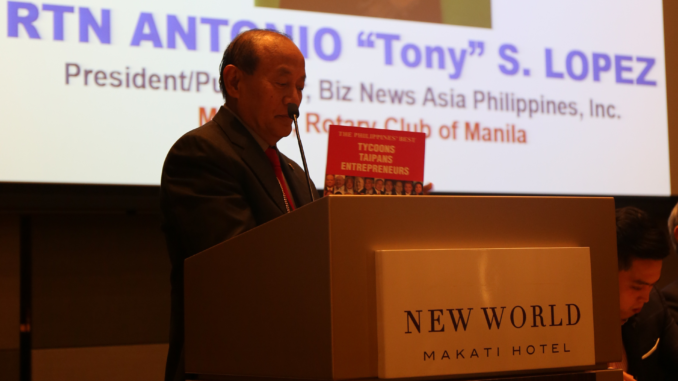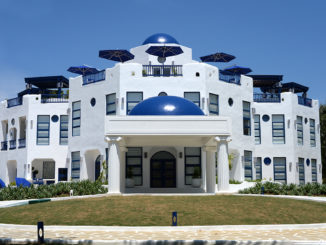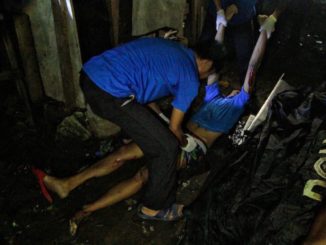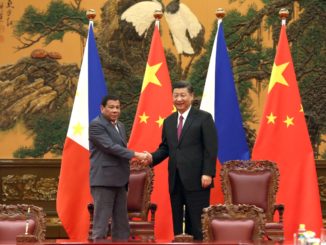
I would like to thank the rotary club of manila, Asia’s first, best and largest Rotary Club, for the honor of being invited as your speaker.
I don’t usually honor invitations to speak before groups like this.
First, it is time-consuming. Just to prepare for this speech, you need at least two hours to draft and many more hours of research. This is rotary, after all, and you have to be serious about the undertaking.
Second, such effort usually has an opportunity cost. Meaning it costs money. In showbiz, they call it TF — talent fee.
But since this is Rotary Club of Manila, i will do it for free.
Today, i am going to discuss four main topics:
One, income inequality in this world, including the Philippines;
Two, the ease of doing business in the Philippines;
Three, family values and why they are important to launch and sustain a business; and four. Emerging media trends.
According to Credit Suisse, the bottom half of the global population own less than one percent of the world’s total wealth. The richest ten percent own 85 percent of global wealth. The richest one percent owns half of global assets.
The same is true in the Philippines. The richest one percent own more than half of the country’s wealth. The richest 100 families own the politics and business of this country.
According to Credit Suisse, there are only 24 Filipinos with wealth of $500 million or more, the so-called ultra high networth (UHNW) individuals.
And that the Philippines has 32,354 us dollar millionaires (or high networth individuals) whose combined wealth is $518 billion, an amount 1.67 times the country’s gross domestic product (GDP) of $310 billion.
The Philippines is a country of 24 million families and a population of 106 million people, of which 62,043,000 (62.043 million) are adults.
On average, each adult Filipino (19 or older) has wealth of $8,335 (debts included), according to Credit Suisse.
Credit Suisse (cs) defines networth as the value of financial assets, plus non-financial assets—principally housing and land, less debts.
Of the 32,354 filipino millionaires, 27,369 (84.59%) have wealth of between $1 million and $5 million;
2,757 (8.5%) have wealth of between $5 million and $10 million;
190 (.587%) have wealth of $50 million to $100 million;
130 (.4) have wealth of $100 million to $500 million; and
24 individuals (.074%) have wealth of $500 million or more.
Credit Suisse’s “Global Wealth Databook 2018” indicates the world has 42 million dollar millionaires. Of that number, 17.349 million individuals are in the united states; 3.479 million in china; 2.8 million in japan; 183,736 in Singapore; 88,845 in Indonesia; 39,814 in Thailand; and 4,943 in Vietnam.
Impact of inequality
Our politics is monopolized by only a few families.
Thus you have two brothers running for senator at the same time; a family running for senator, governor, and congressman at the same time; a candidate running for mayor and a sibling running for vice mayor, with still another sibling running for congressman – and all three are unopposed. Two siblings are battling for the mayorship of Makati.
In Taguig-Pateros district, one family, the Cayetanos, will have a stranglehold. A husband and wife Cayetano are running for Taguig’s two congressional seats. The sister of the husband is running for senator. Their brother and this brother’s wife are running for mayor and vice mayor of Taguig.
In the movie “Troy”, Brat Pitt, playing Achilles, asked after defeating a monster warrior: “is there no one else?”
For these families, monopolies are a source of family or clan pride (“public service is a tradition”), a badge of honor (“the people love us, you know,” as if the people had any choice), and revolting of all, legal and constitutional.
The dynastic monopolies have morphed into political monarchies ruling large cities, large provinces, major regions, and indeed, the entire archipelago. This is democratic inclusion in reverse—a rule by no more than 100 families over the world’s second largest archipelago, 12th largest consumer market, and one of the most dynamic economies in Asia.
What has been the impact of dynastic rule by these 100 political families?
Is it a coincidence that the Philippines has one of the worst income equality ratios in the world, that it is the only major country that failed to solve its poverty after the entire world solved its poverty in 2015, that in ASEAN, it has the highest poverty incidence, the highest unemployment rate, the highest inflation rate, the highest interest rates, and the lowest level of foreign investments?
On ease of doing business
In this year’s world bank study on ease of doing business in 190 countries, the Philippines ranks a disappointing 124th, down a crucial 11 rungs from its already disappointing 113th for 2018. When president Duterte became president, the Philippines was ranked 99th.
In two years, the country went down 25 places. Or 25 other countries improved their business rules, procedures, and costs, and the Philippines did not.
Yet, 99th was already a bad ranking. A total of 190 countries are studied. One half of that is 95. At 99th, the Philippines was below the global average as an easy place for doing business. Since 2016, our ranking has kept getting worse, which means as the years go on, it keeps getting more difficult to do business in the Philippines.
For the Philippine ranking, among ten factors, the world bank surveyed how business is started in Quezon City and how many percent of adult Filipinos have access to credit or loans. The Philippines fared badly in both.
For starting a business, Quezon City ranked 166th among 190 cities of the world. As a place to get credit, the Philippines ranked 184th, out of 190. This means we are one of the worst places on earth to start a business (in the lowest 15 percent) and to obtain a loan (in the lowest 5 percent).
You want to get a loan? You won’t get it. Only 2.7 percent of potential borrowers are covered by the credit bureau, which means only three of every 100 could borrow from their bank. In depth of credit information, the Philippines has a grade of 0 (the worst) out of 8 (the best). The best in depth of credit information—UK and Ecuador: 8.
According to the world bank, a potential software entrepreneur in Canada would take just two procedures, one and a half days and less than one percent of income per capita to start her business in Toronto.
First, she would need to file for federal incorporation and provincial registration online via industry Canada’s electronic filing centre; this costs 200 Canadian dollars ($159) and is completed within a day. Second, she would need to register online for value added tax; this costs nothing and is completed within half a day.
If the same entrepreneur applied in Quezon City, the business incorporation process would require 13 procedures, take 31 days and cost around 20.3 percent of income per capita. She would need to make 14 different tax and contribution payments and visit multiple agencies in person.
Further, the Filipino enterprise would be expected to pay 42.9 percent of its commercial profits in taxes and contributions annually. “Cumbersome business regulatory structures such as these constrain the ability of entrepreneurs to transform their ideas into viable businesses,” laments the 2018 world bank study of 190 countries in ease of doing business.
Among 190 countries, the best in starting a business is New Zealand. Only one step and you get your permit in half a day. In Quezon City, a permit takes at least 13 steps and 31 days (since there is no work on weekends, 31 days is actually 40 days).
The world best in construction permits is 5 steps and 26 days. In the Philippines, a construction permit takes 23 steps and 122 days or at least four months.
To get electricity, a Filipino takes four steps, 37 days, and 21.7 percent of his income per capita. It takes 18 days to get electricity in Korea and UAE (the global best). It costs zero in China, Japan, and UAE.
To register property, the Filipino must endure nine steps and 35 days and pay 4.3 percent of the value of the property. The global best for registering property: one step (Norway, Portugal, Sweden), one day (New Zealand); and zero cost (Saudi Arabia).
Ease of doing business matters.
When the rules for doing business are easy, red tape-free, graft free and less costly, people with some money want to do business. They create companies, put up projects, employ people. In this country, 99 percent of enterprises are small or medium, with capital of p20 million or less. Investments are about jobs.
This country has at least 10 million unemployed or underemployed. To create one job, it takes P2 million. If the government makes it difficult for you to do business, you are better off parking your P2 million in some other place.
One of Rodrigo Duterte’s charming qualities as president is that he hates red tape. Indeed, one distinctive quality in his nearly 23 years as mayor of Davao city is the ease with which businessmen could do business in Davao city. Walang red tape. Walang lagay.
In June this year, Republic Act (RA) 11032, the ease of doing business and efficient government service delivery act of 2018, was enacted.
An Anti-Red Tape Authority (ARTA) was supposed to have been set up last October yet.
Today, there is still no such anti-red tape authority. Why? Red tape.
By the way, have done business with the securities and exchange commission? People there have not heard of Duterte’s dictum of no red tape.
It takes eight months to incorporate, which means your capital lies idle in a bank while the sec takes its time registering your articles of incorporation. You cannot collect because strictly, you are not a legal personality.
Family value and business
The largest corporations in the Philippines are family owned.
San Miguel by Ramon Ang, Eduardo Cojuangco, Inigo Zobel. SM by Henry Sy. JG Summit by John Gokongwei Jr. Ayala by the Zobel-Ayala family. LT Group and PAL by Lucio Tan. Jollibee by Tony Tan Caktiong. ICTSI by Ricky Razon. Vista Land by Manny Villar. Aboitiz Equity Ventures by Aboitiz Equity. Metrobank, Toyota and Federal Land by George Ty. Megaworld and Alliance Global by Andrew Tan. DMCI by Consunji family.
Not a few of these companies are very old. Ayala is 184 years. San Miguel is 128 years. JG Summit is 61 years. The first Aboitiz came to the Philippines in the 1800s.
Why do these companies thrive and last?
First, they are family owned. Being family owned, they were built on old-fashioned virtues of hard work, patience and persistence, integrity, loyalty.
Because their companies are the crown jewels, the families try their best to make the business grow, prosper, and be resilient. They look long term and beyond.
Unlike in America, where business models are calibrated for the short term profits and immediate gains.
When he came from China to the Philippines as a boy of 12, Tatang Henry Sy cried when he saw his father.
His dad’s sari-sari store was so small it also served as his bed and dining table and store all at the same time. ‘This is not the kind of life I would want,’ Tatang Henry told himself. And so he persevered.
“i saw how difficult life was for him, his struggle and hard work to earn a living with that small store, so i cried,” said young Henry.
Today, Henry Sy is the richest Filipino, with wealth of $18 billion, according to Forbes, or $14 billion, according to BizNewsAsia. Today, the three largest public companies are owned by Henry – SM Investments Corp., SM prime, and Banco de Oro. Are three all trillion- peso companies.
Henry Sy’s wealth did not balloon overnight. Or through any short-cuts. He worked 10 to 12 hours daily for decades, even on Saturdays and Sundays.
Success does not come on a silver platter. It is more the result of hard-fought and hard-earned, discipline, persistence, guts, and of course, good luck and good timing.
Henry Sy said, “success is not just good luck. It is a combination of hard work, good credit standing, opportunity, readiness and timing.”
On BizNewsAsia
In the course of the last 17 years, at least four local magazines tried to copy my format – a newsweekly devoted to business and economic news. They all failed eventually and miserably. This year alone, two foreign branded business magazines folded up locally, their print version, that’s Entrepreneur and Forbes Philippines.
BizNewsAsia easily outsells local magazines and foreign brands because of its broad and deep coverage of business, politics and global issues, and outstanding profiles of personalities in business and governance.
We claim a pass-on circulation of 350,000 readers with each copy being read on the average by 10 readers.
We claim 350,000 readers. Why? Because our record sale for a single issue was 35,000 copies, with power 100 issue. That is how compelling we are.
Finally, the market is hungry for a publication like BizNewsAsia. A magazine that focus on the things that count – business, the economy, the Philippines.
Nightly, our major TV stations devote considerable minutes to the inanities of movie stars and showbiz personalities – their quarrels, intrigues, gossip, fashion tastes.
May i suggest: why not reallocate these precious minutes to the good deeds and achievements of our tycoons, taipans, and achievers?
I think our country would be much better off.



